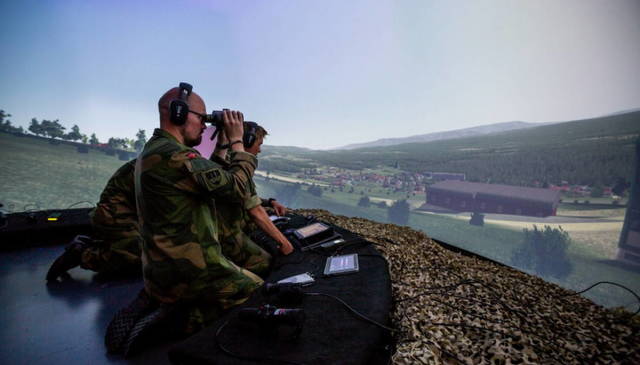Norwegian School of Air and Ground Operations (Air Ground Operations School, AGOS) for aviation guidance specialists and air observers at the end of May 2018 opened a combat simulator called "Advanced Training system for Aviation Gunners and Advanced observers". As stated, this fire support simulation system is one of the most advanced in the world.
After the official presentation and commissioning of the named simulation system, the Norwegian Armed Forces took the leading positions among the NATO states. The advanced training system for aviation gunners and advanced observers (Joint Terminal Attack Controller and Forward Observer Adnanced Trainer System, JFATS) forms the core of all training programs for advanced aviation gunners (Joint Terminal Attack Controller, JTAC) and advanced observers (Joint Fires Observer, JFO; rus. – combined arms observer for the results of fire) in AGOS. In the future, the system equipped by Fidelity Technologies Corporation on the basis of Rena (Rena, about 50 km east of Lillehammer) should become a turning point and the main one in the training structure of the combined tactical fire support of the military personnel of the European countries and especially the Baltic states.
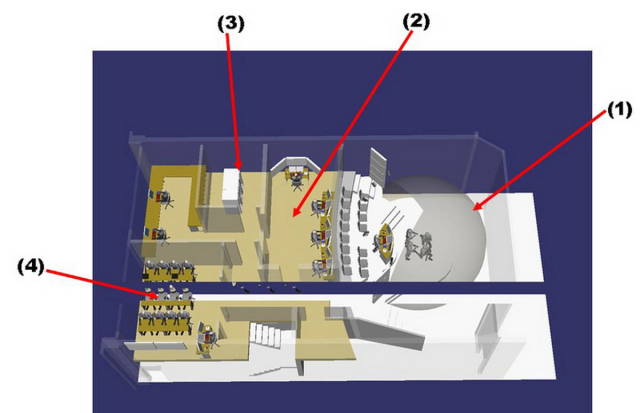
The composition of the "center of excellence"
- Study room under the dome. Instructor, spectator, trainees. Through four flat screens, observers can monitor the preparation process.
- Instructors' room and a multi-purpose pilot station.
- Server room.
- Small study hall.
Until recently, the training of advanced aircraft gunners and advanced observers remained extremely costly both in time and money. Only the performance of real aviation flights and the use of high-precision artillery ammunition allowed for high-quality training and certification of specialists.
In particular, the mandatory requirement for certification of JFATS and JFO in relation to Close Air Support (CAS) are 12 training flights of aviation. If, for some reason (technical or due to weather conditions), the aircraft cannot participate in the exercise, it goes "empty" and requires repetition from the very beginning, as soon as circumstances allow.
For this reason, nowadays it is no longer possible to imagine training without a virtual reality simulator. Today, this is the only way to minimize the number of actual sorties and precision artillery ammunition required.
Combat Simulator: main components and features
JFATS consists of a stationary "Center of Excellence" with a dome (8 m in diameter), training facilities and mobile system complexes. Instructors are offered a choice of practicing the following exercises:
- training of advanced aircraft gunners (JTAC);
- primary choice course;
- basic training;
- advanced training course;
- preparation to the levels of limited (Limited Combat Ready) and full combat readiness (Combat Ready);
- training of a combined arms observer for the results of fire (JFO);
For training scenarios, instructors can use various basic components, environmental factors, pre-programmed tasks, actions and groupings of troops.
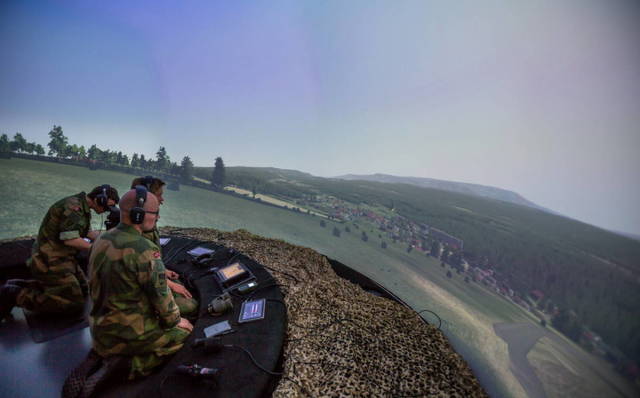
Working out the actions of the joint tactical fire support group on a combat simulator
Combat Simulator Data Bank
The data bank of the combat simulator is able to adapt to the specific requirements of the user. It contains a collection of various elements to display the terrain of the country of interest. The simulator simulates various types of terrain: hills, valleys or plains with built-up areas, desert, jungle, lakes and coastline. Displays various types of roads, ditches, power lines, buildings, military installations, field camps, runways, undamaged or damaged daytime and infrared models, etc.
The terrain data bank correctly displays the physical foundations, generated thermal images, the characteristics of which are simulated in real time and adapted to artificial changes, such as engineering work or the results of the use of weapons on them.
The combat simulator automatically visualizes the correct environmental conditions, taking into account the factors of geographical longitude and latitude, time of day and year, prevailing weather conditions and visibility conditions. The intensity of sunlight or moonlight, the presence of cloud cover (3D format) and its realistic shadow cast on the ground are also taken into account. In addition, wind, rain, fog, haze, snowfall, blizzard, sandstorm and details of the grass cover are simulated.
When simulating direct air support, it is possible from the pilot's position to pass at an altitude over vast territories in accordance with a given airspeed. At the same time, the dynamics of cloud behavior will depend on the selected wind speed and direction.
Object catalog
The data bank of the combat simulator also contains a catalog of objects of various categories:
- individual servicemen, infantry units and other branches of the armed forces of their (allied) forces and the likely enemy;
- various types of military equipment and military materiel: artillery guns, mortars, MANPADS, main battle tanks, armored personnel carriers, infantry fighting vehicles, anti-aircraft guns;
- civilians and various types of animals; vehicles of different types and colors.
The surfaces of all models and objects simulate the features of laser reflection from their real equivalents. All the surface structures of the objects clearly demonstrate the damage received from the use of weapons. Moreover, the trainee very realistically imagines a stationary burning car or a stricken combat vehicle with a burning tower. The aircraft type database contains all user-specific aircraft, and the ammunition database contains all available types of weapons for mounted and direct fire.
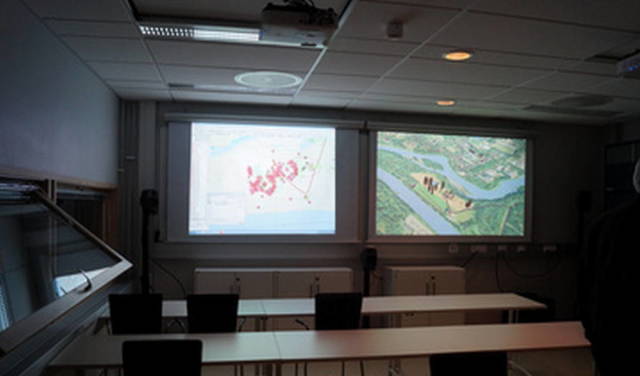
Small study hall
Special Effects
There is no upper limit for adding the number of weapons during subsequent updates of the data bank. When ammunition is fired, the specific ballistic features of the "weapon platform" (for example, an airplane or a gun) are taken into account, thereby achieving an almost real simulation of a probable error in range and direction.
The combat simulator visualizes blinding grenades, tracer bullet trajectories, the highest points of the trajectory for each artillery, mortar or ship shot. Displays the flight time of the projectile, the point of impact and the assessment of the damage caused. It allows you to create a realistic impression of how artificial fog (or smoke) covers the area, spreads over it and dissipates again. Shows the direction of movement of the attacked target from its position.
Special effects (smoke, explosions, gunfire, etc.) are controlled by time during visualization. The same applies to one's own position if, for example, it came under enemy fire. If the targets are hidden by terrain or other obstacle when fired from the air or from the ground, the covering object (barrier) or a piece of terrain is hit, and the damage assessment message reads: "No damage", "Partial damage" or "Total losses".
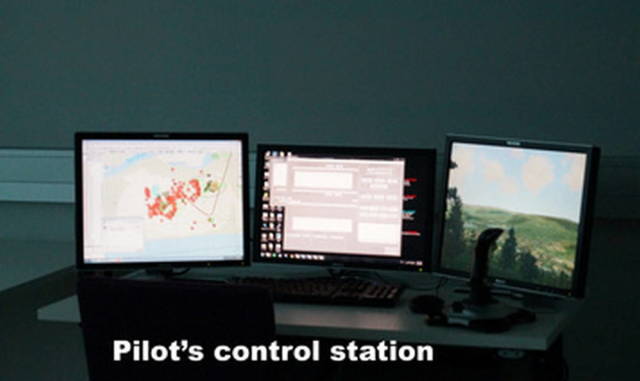
Pilot's workplace
Analysis of the actions of the trainees
All actions or tasks performed by the trainees on the combat simulator are recorded and analyzed after running the script.
To summarize the results in accordance with the sections of the exercise, JFATS has two compatible classrooms. Recordings allow you to restore every keystroke on any device, reproduce all the information on the head-up display, duplicate every radio conversation and the corresponding orientation of the devices. Such digitally recorded information is available to an individual trainee for independent work and additional training.
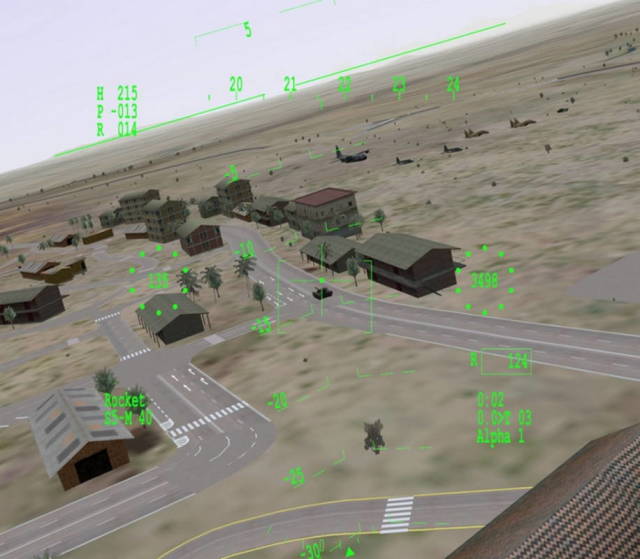
The picture on the pilot's head-up display
Training in conditions close to combat
The training environment of the JFATS combat simulator varies from personal weapons to laser target markers of 11 samples of military simulation equipment (Simulated Military Equipment, SME). In their shape, size and functionality, they correspond to real devices and can be used in any sector of the training dome from any position (standing, kneeling or lying down).
The imitation of communication corresponds to a real voice and radio data. Laser markers, laser target illumination, field binoculars, night vision devices, onboard target illumination devices and head-up displays are simulated and can be used like their real counterparts. In addition, it is possible to reproduce the display of each of these devices on the display screen.
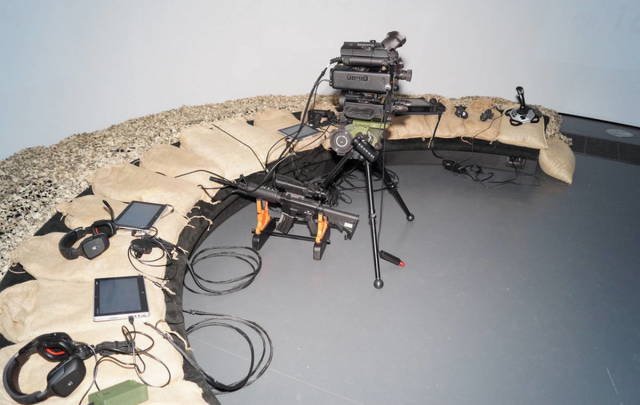
The simulation tools used in the learning process are identical to the real ones
The trainee (JTAC or JFO) uses GPS simulation to determine his own position and his marking of the target with an infrared laser pointer. It is visible to the instructor, the head of the educational process, spectators and pilots on various displays in the system. The simulation of the combat terminal is controlled via a touch screen, on which the trainee simulates the functions of the terminal by entering his data.
The combat simulator demonstrates the terrain map of the current scenario. The multi-user station for pilots simulates an overview with a 180°x20° field, allows you to transmit and receive reports from JTAC from the entire combat environment on the organization of direct air support. In addition, the pilot can also display the mark of his target illumination container on the screen for JTAC. As a result, during training, imitation of combat conditions is achieved.
Mobile educational complexes
The Norwegian AGOS School also has two mobile combat simulator complexes. The complexes are used by the Norwegian artillery, JTAC and special purpose units to practice CAS control and call artillery fire from dismounted positions.
Mobile complexes realize the same realistic impression and the same training opportunities as the 8-meter dome display and replace real fire controls. The mobile combat simulator consists of a pilot action simulation station, a station for instructors and a multi-user JTAC/JFO system.
Together with a removable 3-meter dome, the training system is stowed away in four sturdy plastic boxes, easily transported thanks to its handles and wheels. The mobile training complex weighs about 100 kg and can be installed in 45 minutes without the use of additional tools.
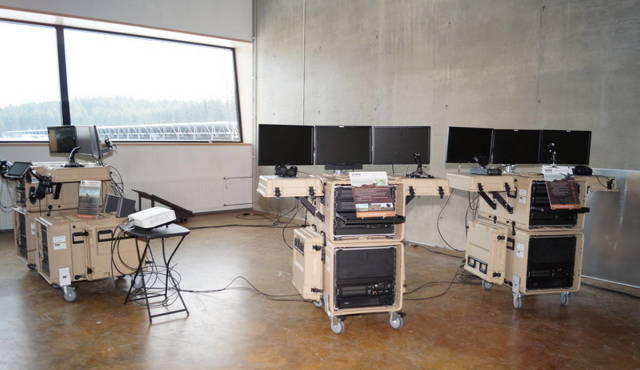
Equipment of a mobile training kit with a 3-meter dome
Costs and benefits
It took 120 computers and more than five kilometers of network cable to install the new JFATS combat simulator at the Ren military base. The initial investment amounted to 90 million Norwegian crowns (about 9.3 million euros). However, according to experts, they pay off every time in comparison with training with the real involvement of aviation and artillery (for example, the cost of one training application of the F-35 fighter is estimated at 110 thousand Norwegian kroner, or about 11,300 euros). Thus, the simulator offers a much more cost-effective solution to achieve and maintain the required level of training.
As you know, NATO currently uses several different types of simulators with similar functionality. However, according to the Norwegian assessment, no other simulator offers the same level of difficulty, realism and learning opportunities as JFATS. In addition, the AGOS simulator and training facilities allow you to save costs of several hundred million Norwegian kroner per year for high-precision ammunition, fuel and flight hours during training in accordance with NATO and US standards.
It is reported that Norway's NATO partners have already demonstrated their interest in JFATS and simulator training.
According to the materials of the resource truppendienst.com
